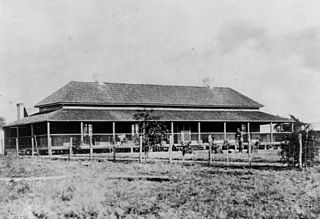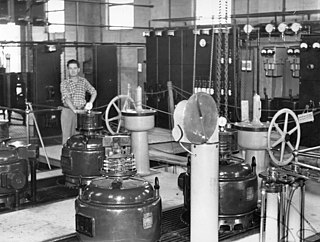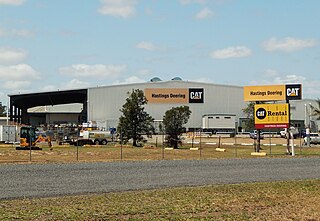
Rockhampton is a city in the Rockhampton Region of Central Queensland, Australia. In the 2021 census, the population of Rockhampton was 79,293. A common nickname for Rockhampton is 'Rocky', and the demonym of Rockhampton is Rockhamptonite.

The Fitzroy River is a river in Central Queensland, Australia. Its catchment covers an area of 142,665 square kilometres (55,083 sq mi), making it the largest river catchment flowing to the eastern coast of Australia. It is also the largest river basin that discharges onto the Great Barrier Reef.

Rockhampton City is the central suburb of the city of Rockhampton in the Rockhampton Region of Queensland, Australia. It is also known as the Rockhampton CBD. In the 2021 census, Rockhampton City had a population of 2,059 people.

The Morning Bulletin is an online newspaper servicing the city of Rockhampton and the surrounding areas of Central Queensland, Australia.

The Shire of Fitzroy was a local government area located in the Capricornia region of Central Queensland, Queensland, Australia, to the immediate west and south of the regional city of Rockhampton. The shire, administered from the town of Gracemere, covered an area of 5,898.7 square kilometres (2,277.5 sq mi), and existed as a local government entity from 1899 until 2008, when it amalgamated with several other councils to become the Rockhampton Region. It is named for the Fitzroy River, that passes along the northern boundary of the shire.

Aramac Station was a pastoral lease that has operated both as a cattle station and a sheep station. It is located about 83 kilometres (52 mi) south east of Muttaburra and 162 kilometres (101 mi) north west of Alpha near the town of Aramac in Queensland.

Raglan is a rural town and locality in the Gladstone Region, Queensland, Australia. In the 2021 census, the locality of Raglan had a population of 143 people.

Bajool is a rural town and locality in the Rockhampton Region, Queensland, Australia. In the 2021 census, the locality of Bajool had a population of 447 people.

St Josephs Cathedral is a heritage-listed Roman Catholic cathedral at 170 William Street, Allenstown, Rockhampton, Rockhampton Region, Queensland, Australia. It was designed by Francis Drummond Greville Stanley and built from 1893 to 1982. It was added to the Queensland Heritage Register on 21 October 1992. The cathedral serves as the seat for the Bishop of Rockhampton.

Alexandra Railway Bridge is a heritage-listed railway bridge adjacent to North Street, Rockhampton, Rockhampton Region, Queensland, Australia. It was designed by Henry Charles Stanley and built from 1898 to 1899 by George Charles Willcocks. It was added to the Queensland Heritage Register on 21 October 1992.
John William Wilson was an architect and builder in Rockhampton, Queensland, Australia. A number of his buildings are now heritage-listed.

Yaamba is a rural town and locality in the Livingstone Shire, Queensland, Australia. In the 2021 census, the locality of Yaamba had a population of 51 people.
North Rockhampton railway station was a railway station in The Common, Rockhampton, Queensland, Australia.

Port Curtis is a suburb of Rockhampton in the Rockhampton Region, Queensland, Australia. In the 2021 census, Port Curtis had a population of 309 people.
Lakes Creek is a suburb split between Rockhampton Region and Shire of Livingstone, Queensland, Australia. In the 2021 census, Lakes Creek had a population of 633 people.
Walter David Taylor Powell was an English mariner and paramilitary Native Police officer in the British colonies of New South Wales and Queensland. He played a significant part in the practical implementation of British colonial rule in the coastal areas of Queensland. His role as an officer in the Native Police was central in a number of important moments in colonial Queensland history including that of the brutal crushing of localised Aboriginal resistance after the Hornet Bank massacre, the foundation of Rockhampton and the creation of the Bowen settlement. He also had major contributions in the founding of Cardwell, the coastal and South Seas trade, and the British colonisation of the Torres Strait.

Rockhampton Council Tramways was a steam tram service which was operated by Rockhampton City Council from 1909 until 1939 in the city of Rockhampton, Queensland, Australia. Rockhampton was the only regional city in the state of Queensland to have had a tram service. The line has since been rebuilt and is operated as a tourist attraction by the Archer Park Rail Museum.

The Fitzroy Bridge was a suspension bridge that spanned the Fitzroy River in Rockhampton, Queensland, Australia from 1881 until it was demolished in 1956.

Thompson Point is a coastal locality in the Livingstone Shire, Queensland, Australia. It was the site of a short-lived town and port called Broadmount. In the 2021 census, Thompson Point had "no people or a very low population".
Rockhampton–Emu Park Road is a continuous 44.1 kilometres (27.4 mi) road route in the Rockhampton and Livingstone local government areas of Queensland, Australia. The route is designated as State Route 4 (Regional) and Tourist Drive 10. It is a state-controlled regional road.

















